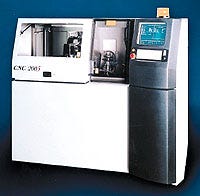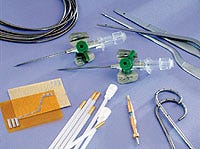July 1, 1999


Machining
CNC Grinder Produces Tools from Blank to Finished Product in One Complete Chucking
Rotary burrs, end mills, and other tools made
A CNC TOOL automatically produces rotary burrs, end mills, router bits, and endodontic and surgical instruments for medical and dental applications. Extremely complex part geometries can be ground in a variety of small diameters.
The CNC 2005 grinder features a small footprint (68 x 52 x 66½ in.) and five separate axes, aswell as a four-axis robot to pick and place blanks. Additional features include fast feed rates and cycle times and very tight tolerances forincreased grinding accuracy.
According to the company, "The CNC 2005 is the only commercially available CNC grinder in the world that is designed for manufacturing small-diameter burrs or other types of tools complete from blank to finished tool in one chucking."
Secondary operations may be done at the same time with an optional piggyback drilling/milling spindle. The system contains four basic blocks: a grinding chamber, a robot, a work spindle, and a computer-controlled tool path. The variable-speed grinding spindle, which rotates between 4000 and 10,000 rpm, grinds the carbide blank in the cutting chamber. A spindle carrying up to three grinding wheels performs functions such as blank preparation and side fluting, as well as makes end cuts and chip breakers. A three-axis robot bearing two sets of jaws is used to pick and place individual burr blanks. The 300–500 blanks contained in each pallet are then ground according to specs generated on a PC design station.
For more information, contact Cutting Edge Technologies at 802/672-3399.

Surface Treatment
A Thin-Film Metallization Process for Cardiac Catheters
Offers increased flexibility and durability
USING ION BEAM TECHNOLOGY to deposit a thin film of metal on polymeric substrates, a metallization process adds electrical conductivity to electrophysiology catheters. The SPI-METAL-EP process developed by Spire Corp. (Bedford, MA) will "assist medical device makers in fabricating more-flexible electrode arrays for cardiac catheterization and similar procedures," according to Ron Scharlack, vice president and general manager of the company. "The process also has potential applications for such implantable devices as small-joint orthopedic implants, urological stents, and tracheotomy tubes." Scharlack also points out that a recent National Heart, Lung, and Blood Institute–sponsored study has shown that the use of electrode catheters in electrophysiology can be an effective strategy in reducing the risk of arrhythmic death or cardiac arrest.
Conventional electrophysiology catheters contain wires and electrodes packed into the middle. The lack of flexibility resulting from this density of conductive materials makes it difficult to navigate the tortuous paths involved in, for example, reaching the heart. The metal coating process leaves a layer on the outside of the catheter from a few Å to 1 µm thick, increasing their flexibility while adding conductivity.
For more information, call Spire Corp. at 781/275-6000.

Equipment
Handheld Operator Interface Features a Touch Screen
Gives the user several interface options
A HANDHELD OPERATOR INTERFACE features a 6.1 in., 640 x 480 VGA touch-screen display that can be oriented for either horizontal or vertical use. Standard features for the TouchLite from Two Technologies Inc. (Horsham, PA) include a 486 microprocessor running at 66 MHz, a fully configurable serial interface, and Microsoft Windows CE operating system. The device is equipped with two PCMCIA-compatible card slots, the first of which can accommodate version I and II, type I, II, or III PCMCIA cards. The second slot can hold 16MB flash EPROM and8 MB DRAM storage cards, which can be supplied by the company. One of the two serial ports onthe device is configurable for RS-232, RS-422, or RS-485, with the other configurable to justRS-232. Additionally, the unit contains front and rear facing IrDA ports, a USB port, and a 10baseT network connection. All of these provide a wide variety of interface options for the user.
The device measures 6.6 x 9.66 x 2.84 in. and is battery powered. SoundBlaster audio compatibility combined with built-in stereo speakers and a microphone allow it to be used for multimedia purposes. An optional magnetic smart card reader can be integrated into the device, making the unit card reader capable upon delivery. For custom applications, the company offers an attachment bus connector.
For more information, call Two Technologies Inc. at 215/441-5305.
Internet
Weekly E-Mail Newsletter Offers Industry Updates
A weekly e-mail newsletter provides news and information of interest to medical device professionals. Sponsored by the Web site Medical Device Link, the free newsletter tracks notable industry trends and announces new additions to the site, including market research reports, news stories, annotated links, supplier directories, and job postings. The newsletter also gives details about upcoming industry trade shows and lets readers know whenever another Canon Communications publication—such as Medical Device & Diagnostic Industry, Medical Product Manufacturing News, IVD Technology, European Medical Device Manufacturer, Medical Electronics Manufacturing, and Pharmaceutical & Medical Packaging News—becomes available on-line. Readers will find a free subscription form at http://www.devicelink.com/register.
Copyright ©1999 Medical Product Manufacturing News
You May Also Like


